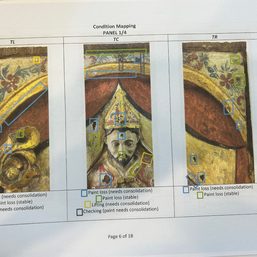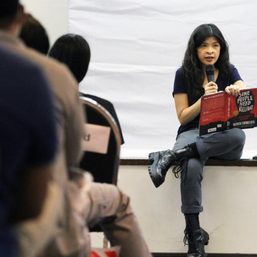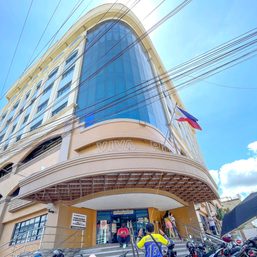SUMMARY
This is AI generated summarization, which may have errors. For context, always refer to the full article.

MANILA, Philippines – “Santo Niño, gagawin mong Santa Dalaga?” (From Holy Child to Holy Maiden?)
Sister Mary John Mananzan, an 85-year-old feminist nun, was aghast after a pageant candidate from Cebu dressed up as the Santo Niño de Cebu. The Santo Niño-themed costume of Joy Dacoron, a Binibining Pilipinas contestant from Cebu, stirred controversy after the pageant organizers posted it on their Facebook page on Tuesday, May 16.
The Santo Niño, an image of the Child Jesus, is a revered icon in the Philippines, especially in Cebu. The Santo Niño de Cebu was the baptismal gift of Portuguese explorer Ferdinand Magellan to Queen Juana of Cebu in 1521. The Santo Niño has since been a symbol of Christianity in the Philippines – and has drawn millions of devotees for reportedly producing miracles and answering prayers.
Sought by Rappler for comment on Thursday, May 18, Mananzan said that upon hearing of the Santo Niño costume, “I right away said, ‘Oh my God, ano ba naman ‘yan, pati ba naman something sacred ay gagamitin nila sa beauty pageant na ‘yan. Maya-maya naka-Santo Niño siya, maya-maya naka-bathing suit na siya. Ano ba ‘yan!”
(I right away said, “Oh my God, what the heck, they are using even something sacred for that beauty pageant.” One moment she is dressed up as the Santo Niño, the next moment she is in a bathing suit. What the heck!)
Mananzan, who is also a well-known activist, said she is against beauty pageants in the first place.
Known for helping develop feminist theology in Asia, the Benedictine nun is the executive director of the Institute of Women Studies of Saint Scholastica’s College. Mananzan is the school’s former president and, even now in her mid-80s, still serves as its vice president for external affairs.
“I am against beauty pageants not as a madre (nun) but as a feminist. Feminists are against beauty pageants because it just emphasizes one aspect of the person,” said Mananzan, adding that while pageants have question-and-answer portions, “it’s still mostly physical.”
“Feminists want a holistic valuation of a woman, the whole of the person and not just the physical attributes,” she said.
‘Desecration’
The use of sacred vestments in a beauty pageant doubles the frustration of Mananzan. “Against na nga ako sa beauty pageant eh. Lalo pa kung gagamitin nila ‘yung sacred ano. Eh ‘di lalong against ako,” she said. (I’m already against beauty pageants. All the more when they use the sacred. I am all the more against it.)
Mananzan said the use of the Santo Niño costume is a form of desecration – “meaning that something is sacred and you use it for secular purposes,” such as a beauty pageant. “You are making less sacred what is sacred,” she said.
The nun rejected arguments that moves like this can help make religion more “mainstream.”
“It does not. It’s desecration nga eh. Desecration will not emphasize the aspect of the religious, because it’s not a religious activity. It’s even very secular – and not only secular but objectionable. How can an objectionable pageant enhance the religiosity of anything?” she said.
Others in the Catholic Church also opposed the use of the Santo Niño costume. The Augustinian friars, who guard the centuries-old Santo Niño de Cebu image in a basilica, said the public should mind the “appropriateness” of their actions.
“As Cebuano Catholics, the Santo Niño has profound religious and cultural importance to us. Let us approach and treat the Santo Niño with reverence and respect in order to avoid conflict and misunderstanding,” read a statement by the Augustinian Friars of the Basilica Minore del Santo Niño de Cebu.
Former Binibining Cebu 2017 candidate Pia Gabuya, however, pointed out what she called the hypocrisy of some critics who would have lauded the use of the holy vestments had it been worn by a child – as seen during the usual Sinulog celebrations.
“The big problem I have here is probably the sexism or machismo at play because they still keep finding fault in her outfit low enough to make her sexuality as a woman, a reason as to why wearing the Santo Niño costume is wrong,” Gabuya said.
Similar controversies involving saintly images and beauty pageants have erupted outside Cebu.
In Albay, two Daragang Magayon Festival candidates – Jessabel Zuniega Cending and Thiara Marie San Pablo – drew public backlash for wearing vestments associated with the Virgin Mary. At the Binibining Pilipinas, a candidate from Naga City, Paulina Marie Labayo, was criticized for wearing the vestments of Our Lady of Peñafrancia, a popular religious icon in Bicol.
Legazpi Bishop Joel Baylon described the acts as “inappropriate” but stopped short of considering them blasphemous.
“While it borders on that, one cannot say, however, that this is an act of blasphemy. I believe it was not done to mock or disrespect the Blessed Mother. But, still, it was done insensitively,” Baylon said. – with reports from John Sitchon and Rhaydz Barcia/Rappler.com
Add a comment
How does this make you feel?















There are no comments yet. Add your comment to start the conversation.